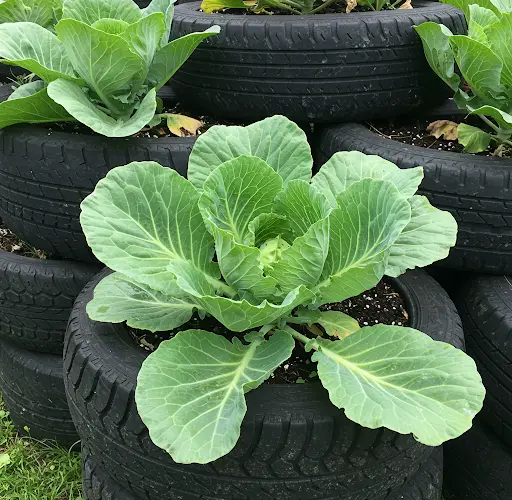Growing Cabbage in Tires – The Secret to Growing Cabbage Fast and Big
If you’re looking for a smart, cost-effective way to grow cabbage that thrives quickly and grows impressively large, consider using old tires. Yes—those discarded tires can become powerful planting tools that help you grow cabbage more efficiently, even in limited spaces. Whether you’re a backyard gardener or just starting out with container gardening, this method is worth exploring.
Why Use Tires for Cabbage?
Recycling old tires into planting beds has several benefits. First, they provide a compact, durable growing space that retains warmth—something cabbage loves. The black rubber absorbs sunlight, creating a slightly warmer microclimate inside the tire. This helps the soil stay warm longer into the evening, boosting early growth, especially during cooler seasons.
Tires are also elevated, helping protect plants from pests like snails and slugs, and they naturally create a contained space that makes weeding and watering more efficient. Plus, it’s an eco-friendly solution, giving new life to waste materials that would otherwise end up in landfills.
Getting Started – Materials You’ll Need
To grow cabbage in tires, gather the following items:
-
Old car tires (cleaned and free from oil or chemicals)
-
Quality potting soil or garden soil enriched with compost
-
A base layer like gravel or coarse sand for drainage
-
Organic fertilizer (compost, cow manure, fermented fertilizer, or a balanced NPK organic mix)
-
Healthy cabbage seedlings or seeds
-
Mulch (straw, dried leaves, or rice husks)
Choose a sunny location—cabbage grows best with at least 6 hours of sunlight per day.
Step-by-Step Guide to Growing Cabbage in Tires
1. Prepare the Tire Bed
Select one or two tires per plant. Stack two tires if you want deeper soil for root development, especially for larger cabbage varieties. Place the tire(s) directly on soil or on a layer of bricks for drainage. Add a layer of gravel or broken pieces of brick at the bottom for better water flow.
2. Add Soil and Fertilizer
Fill the tire with a rich soil mix. Combine garden soil with compost or aged cow manure. Add a handful of organic fertilizer or bone meal to give the plants a strong start. Cabbage is a heavy feeder, so nutrient-rich soil is key.
3. Planting
You can either sow seeds directly or transplant seedlings. For faster results, transplant healthy cabbage seedlings when they are about 3–4 weeks old. Plant one seedling per tire for optimal space and growth. Water gently after planting.
4. Mulching
After planting, cover the soil surface with mulch. This retains moisture, suppresses weeds, and helps regulate soil temperature. Organic mulch like dried leaves or rice husks will also decompose slowly, adding nutrients over time.
Care and Maintenance
Watering
Cabbage needs consistent moisture to develop properly. Water deeply every few days, more frequently in hot weather. Avoid waterlogging, especially if your tires are placed in low-lying areas.
Fertilizing
Supplement feeding every 2–3 weeks with diluted organic liquid fertilizer or fermented plant juice. A cabbage plant that is well-fed will grow faster and form tighter, heavier heads.
Pest Control
Keep an eye out for common cabbage pests like aphids, cutworms, and cabbage loopers. Use neem oil spray or homemade garlic-chili solutions to deter insects. Remove caterpillars by hand where possible. The elevated tire structure also helps reduce ground-dwelling pests.
Weeding
Since the planting area is small and contained, weeds are easy to manage. Regularly remove any that appear to prevent them from stealing nutrients.
Harvesting
Depending on the variety, cabbage typically matures in 70–90 days. You’ll know it’s ready when the head feels firm and solid. Use a sharp knife to cut the head at the base, leaving the outer leaves and stem if you plan to get a secondary mini crop (yes, some varieties will regrow small heads!).
Bonus Tips for Success
-
Rotate your tire beds each season or refresh the soil to prevent nutrient depletion and disease buildup.
-
Don’t overcrowd your plants—good air circulation reduces fungal issues.
-
Add crushed eggshells around the base to deter snails and provide calcium.
-
For an extra boost, feed cabbage with fermented banana peel water or seaweed extract during the head-forming stage.
Final Thoughts
Growing cabbage in tires is a practical and rewarding way to maximize small spaces and reuse materials in a sustainable manner. With the right soil, sunlight, and care, this method can produce surprisingly large and healthy cabbage heads in a short time. Whether you’re a seasoned gardener or trying something new, give tire gardening a try—it might just become your favorite way to grow leafy greens.



